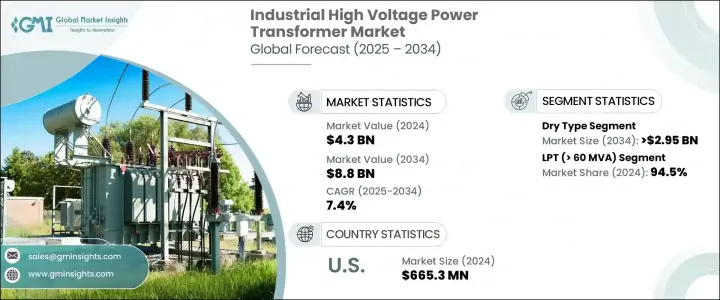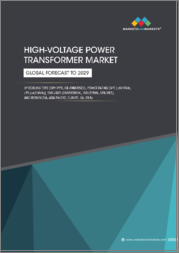
|
시장보고서
상품코드
1766308
세계의 산업용 고압 전력 변압기 시장 : 기회, 성장 촉진요인, 산업 동향 분석, 예측(2025-2034년)Industrial High Voltage Power Transformer Market Opportunity, Growth Drivers, Industry Trend Analysis, and Forecast 2025 - 2034 |
||||||
세계의 산업용 고압 전력 변압기 시장 규모는 2024년 43억 달러에 달했고, CAGR 7.4%로 성장해 2034년까지 88억 달러에 이를 것으로 추정되고 있습니다.
수력 발전, 태양광 발전, 풍력 발전 등 재생 가능 전원으로의 급속한 시프트는 전력 변동을 관리하고 장거리 송전을 가능하게 하는 차세대 변압기 수요를 촉진하고 있습니다. 이것은 원격지의 에너지 생산 기지와 고밀도 도시 지역을 연결하는 데 필수적입니다. 지난 20년간 세계 전력 사용량은 산업화의 진전과 디지털화를 통해 다른 모든 에너지를 능가해 왔습니다. 송전망사업자와 유틸리티자는 에너지배급망을 근대화하기 위해 IoT 대응 변압기나 디지털 변전소 등 스마트 기술에 주목하고 있습니다.

특히 아시아태평양에서는 도시 확대와 산업 개발 증가로 탄력성과 적응성이 우수한 전기 인프라에 대한 요구가 계속 증가하고 있습니다. 많은 변압기가 서비스 수명을 맞이하고 있으며 안정적이고 효율적인 전력 공급을 유지하기 위해서는 시스템 업그레이드 및 완전 교체가 필수적입니다. 또한 디지털 인프라, 특히 데이터센터의 전력 수요가 급증하면 대용량의 신뢰성 있는 변압기 시스템으로의 이동이 가속화되고 있습니다. 시장의 기세는 송전망의 성능을 높이고, 환경 목표를 달성하고, 대규모 전기 이니셔티브를 지원하는 노력에 의해 지원됩니다.
| 시장 범위 | |
|---|---|
| 시작 연도 | 2024년 |
| 예측 연도 | 2025-2034년 |
| 시작 금액 | 43억 달러 |
| 예측 금액 | 88억 달러 |
| CAGR | 7.4% |
건식 냉각 변압기 분야가 시장을 선도하고 2034년에는 29억 5,000만 달러에 이를 것으로 예측됩니다. 이 시스템은 바닥 면적과 화재 위험을 효과적으로 관리해야하는 수요 센터 근처에서 널리 사용됩니다.
LPT(>60MVA) 부문은 2024년 94.5%의 점유율을 차지했으며, 2034년까지 강력한 성장 궤도를 유지할 것으로 예측됩니다. 정부 투자는 이 부문을 더욱 강화하고 있습니다. 이러한 대형 변압기는 유틸리티 규모의 재생에너지 설비를 주요 송전망에 연결하는 데 매우 중요합니다.
2024년 미국 산업용 고압 전력 변압기 시장 규모는 6억 6,530만 달러로 인프라의 노후화가 여전히 국내 시장 수요를 견인하고 있습니다. 인프라에 필수적인 변압기의 현지 생산 확대에 초점을 맞춘 폭넓은 이니셔티브의 일환으로 전략적 투자가 활발해지고 있습니다.
세계의 산업용 고압 전력 변압기 시장에서 활약하는 주요 기업으로는 Bharat Heavy Electricals Limited, CG Power & Industrial Solutions, Toshiba Energy Systems & Solutions Corporation, WEG, Hitachi Energy, HD HYUNDAI ELECTRIC, Siemens Energy, ABB, JSHP Trans Industries, Bharat Bijlee Limited, LS ELECTRIC, and Kirloskar Electric Company 등이 있습니다. 산업용 고압 전력 변압기 시장의 주요 기업은 경쟁력을 강화하기 위해 몇 가지 핵심 전략에 주력하고 있습니다. 많은 기업은 지역 공급망을 확보하고 리드타임을 단축하기 위해 제조거점을 확대하고 있습니다. 전력회사나 정부기관과의 파트너십은 대규모 인프라 계약 확보에 도움을 주고 있습니다.
목차
제1장 조사 방법과 범위
제2장 주요 요약
제3장 업계 인사이트
- 생태계 분석
- 규제 상황
- 업계에 미치는 영향요인
- 성장 촉진요인
- 업계의 잠재적 위험 및 과제
- 성장 가능성 분석
- Porter's Five Forces 분석
- PESTEL 분석
제4장 경쟁 구도
- 소개
- 전략적 대시보드
- 기업의 시장 점유율 분석
- 전략적 노력
- 기업 벤치마킹
- 혁신과 기술의 상황
제5장 시장 규모와 예측 : 냉각 방법별, 2021-2034년
- 주요 동향
- 드라이 유형
- 오일 침지
제6장 시장 규모와 예측 : 레이트별, 2021-2034년
- 주요 동향
- SPT(60 MVA 미만)
- LPT(60 MVA 이상)
제7장 시장 규모와 예측 : 지역별, 2021-2034년
- 주요 동향
- 북미
- 미국
- 캐나다
- 멕시코
- 유럽
- 영국
- 프랑스
- 독일
- 이탈리아
- 러시아
- 스페인
- 아시아태평양
- 중국
- 일본
- 한국
- 호주
- 인도
- 중동 및 아프리카
- 사우디아라비아
- 아랍에미리트(UAE)
- 남아프리카
- 라틴아메리카
- 브라질
- 아르헨티나
제8장 기업 프로파일
- ABB
- Bharat Bijlee Limited
- Bharat Heavy Electricals Limited
- CG Power & Industrial Solutions
- DAIHEN Corporation
- General Electric
- HD HYUNDAI ELECTRIC
- Hitachi Energy
- Hyosung Heavy Industries
- JSHP Transformer
- Kirloskar Electric Company
- LS ELECTRIC
- Siemens Energy
- Toshiba Energy Systems & Solutions Corporation
- WEG
The Global Industrial High Voltage Power Transformer Market was valued at USD 4.3 billion in 2024 and is estimated to grow at a CAGR of 7.4% to reach USD 8.8 billion by 2034. Rapid shifts toward renewable power sources like hydropower, solar, and wind are prompting the demand for next-generation transformers that can manage power fluctuations and enable long-range electricity transmission. This is vital for linking remote energy production sites to high-density urban regions. Over the past 20 years, global electricity usage has outpaced all other energy types, driven by increased industrialization and digitalization. Grid operators and utilities are turning to smart technologies, including IoT-enabled transformers and digital substations, to modernize energy distribution networks.

Urban expansion and rising industrial development, particularly across the Asia Pacific, continue to create a greater need for resilient and adaptable electrical infrastructure. With many transformers nearing the end of their operational lifespan, system upgrades or complete replacements are becoming essential for maintaining stable and efficient power delivery. Additionally, the surge in electricity demand from digital infrastructure, especially data centers, is accelerating the shift toward high-capacity, reliable transformer systems. The market's momentum is sustained by efforts to enhance grid performance, meet environmental targets, and support large-scale electrification initiatives.
| Market Scope | |
|---|---|
| Start Year | 2024 |
| Forecast Year | 2025-2034 |
| Start Value | $4.3 Billion |
| Forecast Value | $8.8 Billion |
| CAGR | 7.4% |
Dry-type cooling transformers segment is projected to lead the market and is expected to reach USD 2.95 billion by 2034. These transformers use non-flammable insulation materials, making them well-suited for locations with higher fire safety requirements. Their design makes them ideal for use in compact spaces and high-risk zones. The rising enforcement of fire safety and environmental codes across commercial and industrial sectors is increasing the preference for dry-type units. These systems are widely used near demand centers where floor space and fire risk must be managed effectively. Without the need for oil-based insulation, dry-type transformers eliminate the need for leak monitoring, making them a low-maintenance and cleaner solution for many facilities.
The LPT (> 60 MVA) segment accounted for 94.5% share in 2024 and is projected to maintain a strong growth trajectory through 2034. These units are crucial for supporting long-distance transmission networks and forming cross-border or interstate power grids. Major government investments in Ultra High Voltage infrastructure are further strengthening this segment. These large power transformers are critical in connecting utility-scale renewable installations to the main transmission grid. Their ability to step up voltage for efficient, high-capacity transmission makes them indispensable to national electrification and grid modernization plans.
U.S. Industrial High Voltage Power Transformer Market was valued at USD 665.3 million in 2024. Aging infrastructure remains the top driver of domestic market demand. Many of the country's transformers are over two decades old and are being phased out in favor of advanced systems. Strategic investments are ramping up as part of broader initiatives focused on grid reliability, national energy security, and expanding local manufacturing of transformers considered critical to infrastructure. The growing use of renewable energy, paired with rising needs for electrification-especially in areas like EV charging networks-is fueling increased adoption of modern high-efficiency transformer systems.
Key companies active in the Global Industrial High Voltage Power Transformer Market include Bharat Heavy Electricals Limited, CG Power & Industrial Solutions, Toshiba Energy Systems & Solutions Corporation, WEG, Hitachi Energy, HD HYUNDAI ELECTRIC, Siemens Energy, ABB, JSHP Transformer, General Electric, DAIHEN Corporation, Hyosung Heavy Industries, Bharat Bijlee Limited, LS ELECTRIC, and Kirloskar Electric Company. Leading companies in the industrial high-voltage power transformer market are focused on several core strategies to strengthen their competitive edge. A major emphasis is placed on developing advanced transformer technologies that support digital monitoring, improve energy efficiency, and align with global renewable integration goals. Many firms are expanding their manufacturing footprints to secure regional supply chains and reduce lead times. Partnerships with utilities and government bodies help secure large-scale infrastructure contracts. Players are also investing in R&D for dry-type, oil-free, and eco-efficient transformers to comply with evolving safety and environmental standards.
Table of Contents
Chapter 1 Methodology & Scope
- 1.1 Market definitions
- 1.2 Base estimates & calculations
- 1.3 Forecast calculation
- 1.4 Data sources
- 1.4.1 Primary
- 1.4.2 Secondary
- 1.4.2.1 Paid
- 1.4.2.2 Public
Chapter 2 Executive Summary
- 2.1 Industry synopsis, 2021 - 2034
Chapter 3 Industry Insights
- 3.1 Industry ecosystem analysis
- 3.2 Regulatory landscape
- 3.3 Industry impact forces
- 3.3.1 Growth drivers
- 3.3.2 Industry pitfalls & challenges
- 3.4 Growth potential analysis
- 3.5 Porter's analysis
- 3.5.1 Bargaining power of suppliers
- 3.5.2 Bargaining power of buyers
- 3.5.3 Threat of new entrants
- 3.5.4 Threat of substitutes
- 3.6 PESTEL analysis
Chapter 4 Competitive Landscape, 2025
- 4.1 Introduction
- 4.2 Strategic dashboard
- 4.3 Company market share analysis, 2024
- 4.4 Strategic initiatives
- 4.5 Company benchmarking
- 4.6 Innovation & technology landscape
Chapter 5 Market Size and Forecast, By Cooling, 2021 - 2034, (USD Million, Units)
- 5.1 Key trends
- 5.2 Dry type
- 5.3 Oil immersed
Chapter 6 Market Size and Forecast, By Rating, 2021 - 2034, (USD Million, Units)
- 6.1 Key trends
- 6.2 SPT (≤ 60 MVA)
- 6.3 LPT (> 60 MVA)
Chapter 7 Market Size and Forecast, By Region, 2021 - 2034, (USD Million, Units)
- 7.1 Key trends
- 7.2 North America
- 7.2.1 U.S.
- 7.2.2 Canada
- 7.2.3 Mexico
- 7.3 Europe
- 7.3.1 UK
- 7.3.2 France
- 7.3.3 Germany
- 7.3.4 Italy
- 7.3.5 Russia
- 7.3.6 Spain
- 7.4 Asia Pacific
- 7.4.1 China
- 7.4.2 Japan
- 7.4.3 South Korea
- 7.4.4 Australia
- 7.4.5 India
- 7.5 Middle East & Africa
- 7.5.1 Saudi Arabia
- 7.5.2 UAE
- 7.5.3 South Africa
- 7.6 Latin America
- 7.6.1 Brazil
- 7.6.2 Argentina
Chapter 8 Company Profiles
- 8.1 ABB
- 8.2 Bharat Bijlee Limited
- 8.3 Bharat Heavy Electricals Limited
- 8.4 CG Power & Industrial Solutions
- 8.5 DAIHEN Corporation
- 8.6 General Electric
- 8.7 HD HYUNDAI ELECTRIC
- 8.8 Hitachi Energy
- 8.9 Hyosung Heavy Industries
- 8.10 JSHP Transformer
- 8.11 Kirloskar Electric Company
- 8.12 LS ELECTRIC
- 8.13 Siemens Energy
- 8.14 Toshiba Energy Systems & Solutions Corporation
- 8.15 WEG















